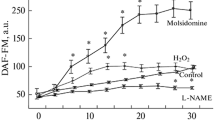Abstract
The unidirectional influx of hypoxanthine across cerebral capillaries, the anatomical locus of the blood=brain barrier, was measured with an in situ rat brain perfusion technique employing [3H]hypoxanthine. Hypoxanthine was transported across the blood-brain barrier by a saturable system with a one-half saturation concentration of approximately 0.4 mM. The permeability-surface area product was 3×10−4 sec−1 with a hypoxanthine concentration of 0.02 μM in the perfusate. Adenine (4 mM) and uracil and theophylline (both 10 mM), but not inosine (10 mM) or leucine (1 mM), inhibited hypoxanthine transfer through the blood-brain barrier. Thus, hypoxanthine is transported through the blood-brain barrier by a high-capacity, saturable transport system with a half-saturation concentration about 100 times the plasma hypoxanthine concentration. Although involved in the transport hypoxanthine from blood into brain, this system is not powerful enough to transfer important quantities of hypoxanthine from blood into brain.
Similar content being viewed by others
References
Mandel P., and Wintzerith M. 1980. Free nucleotides and nucleic acids during brain development. Pages 241–282,in Kumar, S. (ed.), Biochemistry of Brain, Pergamon Press, New York.
MacDonnell P., Huff K., Grouse L., and Guroff G. 1980. Brain nucleic acids. Pages 211–240,in Kumar, S. (ed.), Biochemistry of Brain, Pergamon Press, New York.
Moyer J. D., and Henderson J. F. 1983. Salvage of circulating hypoxanthine by tissues of the mouse. Can. J. Biochem. Cell Biol. 61:1153–1157.
Held I., and Wells W. 1969. Observations on purine metabolism in rat brain. J. Neurochem. 16:529–536.
Held I., Wells W., and Koenig H. 1969. Metabolic effects of azaserine in rat brain. J. Neurochem. 16:537–542.
Howard W. J., Kerson L. A., and Appel S. H. 1970. Synthesis de novo of purines in slices of rat brain and liver. J. Neurochem. 17:121–123.
Santos J. N., Hempstead K. W., Kopp L. E., and Miech R. P. 1968. Nucleotide metabolism in rat brain. J. Neurochem. 15:367–376.
Boulieu R., Bory C., Baltassat P., and Gonnet C. 1983. Hypoxanthine and xanthine levels determined by high-performance liquid chromatography in plasma, erythrocyte, and urine samples from healthy subjects: The problem of hypoxanthine level evolution as a function of time. Anal. Biochem. 129:398–404.
Eells J., and Spector R. 1983. Determination of ribonucleosides, deoxyribonucleosides and purine and pyrimidine bases in adult rabbit cerebrospinal fluid and plasma. Neurochem. Res. 8:1307–1320.
Eells J., and Spector R. 1983. Purine and pyrimidine base and nucleoside concentrations in human cerebrospinal fluid and plasma. Neurochem. Res. 8:1451–1447.
Cornford E. M., and Oldendorf W. H. 1975. Independent blood-brain barrier transport systems for nucleic acid precursors. Biochim Biophys Acta 394:211–219.
Betz A. L. 1985. Identification of hypoxanthine transport and xanthine oxidase activity in brain capillaries. J. Neurochem. 44:574–579.
Berlin R. D. 1969. Purines: Active transport by isolated choroid plexus. Sciences 163:1194–1195.
Nelson J. A., and Cserr H. F. 1976. Transport and metabolism of purines by isolated choroid plexus, liver and brain in the spiny dogfish, Squalus Acanthias. Comp. Biochem. Physiol. 53B:371–377.
Takasato Y., Rapoport S. I., and Smith Q. R. 1984. An in situ brain perfusion technique to study cerebrovascular transport in the rat. Am. J. Physiol. 247:H484-H493.
Spector R., Sivesind C., and Kinzenbaw D. 1986. Pantothenic acid transport through the blood-brain barrier. J. Neurochem. 47:966–972.
Smith Q. R., Takasato Y., and Rapoport S. I. 1984. Kinetic analysis ofl-leucine transport across the blood-brain barrier. Brain Res. 311:167–170.
Spector, R. 1987. Niacinamide transport through the blood-brain barrier. Neurochem. Res. 12:27–31.
Greenwood J., Love E. R., and Pratt O. E. 1982. Kinetics of thiamine transport across the blood-brain barrier in the rat. J. Physiol. (Lond.) 327:95–103.
Spector R. 1982. Nucleoside transport in choroid plexus: Mechanism and specificity. Arch. Biochem. Biophys. 216:693–703.
Spector R. 1985. Uridine transport and metabolism in the central nervous system. J. Neurochem. 45:1411–1418.
Scharrer E., Raab W., Tiemeyer W., and Amann B. 1981. Active absorption of hypoxanthine by lamb jejunum in vitro. Pluegers Arch. 391:41–43.
Author information
Authors and Affiliations
Rights and permissions
About this article
Cite this article
Spector, R. Hypoxanthine transport through the blood-brain barrier. Neurochem Res 12, 791–796 (1987). https://doi.org/10.1007/BF00971517
Accepted:
Issue Date:
DOI: https://doi.org/10.1007/BF00971517




